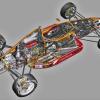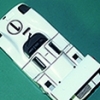1.5 litre, turbocharged, 2 stroke F1 engine - 1974-75
#1

Posted 03 October 2006 - 19:15
Does anyone have any recollections of ever hearing about, reading about - or indeed (best case) of having been involved as part of a compact team of British-based engineers developing a 1.5-litre turbocharged 2-stroke Formula 1 engine as early as 1974-75?
DCN
Advertisement
#2

Posted 03 October 2006 - 20:42
#3

Posted 03 October 2006 - 21:04
#4

Posted 03 October 2006 - 21:06
I have just a vague recollection of hearing mention of such a thing, Doug, but really can't remember what or where...
hopefully others can recall as it does sound intriguing.
#5

Posted 03 October 2006 - 21:14
Originally posted by Doug Nye
Here's a strange one.
Does anyone have any recollections of ever hearing about, reading about - or indeed (best case) of having been involved as part of a compact team of British-based engineers developing a 1.5-litre turbocharged 2-stroke Formula 1 engine as early as 1974-75?
DCN
Would a turbo 2 stroke actually work? Putting a turbine in the exhaust stream isn't exactly going to be of assistance to the extraction process, like an expansion chamber. Has there ever been a turbocharged 2 stroke? I think not.
Are you sure we shouldn't be talking about a supercharger, Doug? Mechanically driven forced
induction would have been a nice idea for a 2 stroke 1.5 F1 engine. (with very big fuel tanks though!)
#6

Posted 03 October 2006 - 21:24
#7

Posted 03 October 2006 - 21:39
#8

Posted 03 October 2006 - 21:40
#9

Posted 03 October 2006 - 21:45
Wrong period - this lunacy was mid-1960s - but I'm getting closer.
#10

Posted 03 October 2006 - 22:58
Two stroke turbocharged diesels are used routinely for very large marine engines, so at least it works for very large, slow-revving, long-stroke engines running at more or less constant revs.
Wasn't the (Australian, IIRC) Orbital engine also a turbocharged two-stroke? I'll need to do a Google on that.
As for the engine concept I mentioned in my previous post, I'm getting more convinced now that I may be mixing memories of a number of different engines, not specifically any F1 turbocharged two-stroke.
I also recall something about a Husquarna two-stroke sometime in the mid to late 1970s, but IIRC that was for Formula 2. I think there was a small article and a photo of it installed in a March F2 chassis (782, IIRC) in Autosport.
Or maybe I'm just going senile... :
#11

Posted 03 October 2006 - 23:06
A British project - 1974-75ish... This isn't a wind-up, I'm as puzzled as anyone.
DCN
#12

Posted 04 October 2006 - 06:50
Originally posted by Bonde
David,
I also recall something about a Husquarna two-stroke sometime in the mid to late 1970s, but IIRC that was for Formula 2. I think there was a small article and a photo of it installed in a March F2 chassis (782, IIRC) in Autosport.
:
You are right about the Husqvarna-based F2 engine. Someone in Sweden got the idea of connecting five Husqvarna 400 cc two-stroke motocross engines by chain-drive and then installing it in March chassis. I don´t think they ever managed to get a functioning transmission, so it never ran.
#13

Posted 04 October 2006 - 06:55
There are examples of forced-induction 2-stroke diesels, I believe; are these always supercharged then David (eg: the Ecurie Ecosse transporter) rather than turbine-assisted?Originally posted by David Beard
Has there ever been a turbocharged 2 stroke? I think not. Are you sure we shouldn't be talking about a supercharger...
#14

Posted 04 October 2006 - 07:02
Originally posted by David Beard
Would a turbo 2 stroke actually work? Putting a turbine in the exhaust stream isn't exactly going to be of assistance to the extraction process, like an expansion chamber. Has there ever been a turbocharged 2 stroke? I think not.
My thoughts as well David.
What has prompted this question Doug, has someone definitely said this was tested are there any more fragments of information to go on ?
#15

Posted 04 October 2006 - 07:34
DCN
#16

Posted 04 October 2006 - 10:26
#17

Posted 04 October 2006 - 12:07
1) The Treen 'Excalibur' X configuation proposal about 1968
2) A turbocharged 750cc opposed piston engine proposal by some students at Cambridge University about 1958.
3) Phil Vincent (of Vincent Motorcyle fame) was involved with a novel two-stroke cycle engine in the 1970's. Also Phil Irving made some racing car engine proposals about the same period but I can find no trace of them or recall whether or not they turned into 'metal'!
Maybe somebody will remember.
Also at the risk of opening this discussion to a much wider field: the two-stroke cycle engine responds extremely well to the application of turbocharging, recall the Foden Mk7 truck engine and several others.
Gary
#18

Posted 04 October 2006 - 12:12
Originally posted by David Beard
Would a turbo 2 stroke actually work? Putting a turbine in the exhaust stream isn't exactly going to be of assistance to the extraction process, like an expansion chamber. Has there ever been a turbocharged 2 stroke? I think not.
Don't forget that not all two-strokes are the Day-cycle as in strimmers and BSA Bantams! Anyway, they require some back-pressure to work properly.
A twin-piston two-stroke (other than the Trojan) requires external pumping of some sort, and in the case of the Vintage Fiat racing engine, the Commer TS series and many others, a roots blower was used. A turbocharger can easily provide that pumping. As this isn't the technical forum, I won't provide the full explanation.
#19

Posted 04 October 2006 - 12:48
Originally posted by Allan Lupton
As this isn't the technical forum, I won't provide the full explanation.
But please do...I'm sure those that aren't interested won't read this thread anyway.
Advertisement
#20

Posted 04 October 2006 - 14:27
I will do some more research but I feel it was first muted in the mid to late 60's
ace
#21

Posted 04 October 2006 - 14:28
Then there was the incredibly complex Napier Nomad two-stroke forced induction piston-cum-turbine diesel aviation engine which had an exhaust blown turbine and compressor arrangement which was also separately fueled (apart from residual exhaust flow from the piston portion of the engine), as well as being geared to the crankshaft...A fascinating compound engine.
I'll only post again in this thread if I have anything to contribute to Doug's opening post request - which I very much doubt will happen, I'm afraid.
#22

Posted 04 October 2006 - 15:22
From my time at Lotus, I don't recall seeing or hearing any war stories, but the "museum" area did have a few rather odd-looking piles of engine parts (including the complete 1.5 litre F1 turbo engine funded by Toyota during their time of part-ownership of the firm). Lotus also certainly dabbled with 2-strokes many times later than the period of DCN's query, and were involved with some vehicle adaptation work for Orbital under my watch .... but that's another tale!
However, with Doug's Hethel connections, I am sure this is a line he's already excluded, so I'll stop rambling!
Dave
#23

Posted 04 October 2006 - 16:22
#24

Posted 04 October 2006 - 18:44
Originally posted by f1steveuk
The other was a two stroke, turbo F1 engine, based loosely on the opposed cylinder arrangement of a Commer commercial engine of opposed pistons.
I hope it was'nt the same size as the Commer TS3, the front wheels would never have touched the ground! As mentioned previously Foden also produced a Turbo 2 stroke diesel, as did Detroit Diesel which may or may not have been the engine in the Bedford bus, given they were all part of GM. The Commer and the Foden are two of my faveourite sounding engines of all time, the follow on TS4 could have been a world beater but like so many British products of the time it was scrapped (as I recall at the behest of Cummins who had signed an engine deal with Rootes/Dodge/Karrier).
This mystery engine sounds very intrigueing anyway, a two stroke F1 - when were the rules changed to forbid such a thing? Imagine the pollution!
Also Stoatspeed what more can you tell us about the Toyota F1 engine that Lotus recieved - any dates, did it run etc?
#25

Posted 04 October 2006 - 18:49
Originally posted by David Beard
Would a turbo 2 stroke actually work? Putting a turbine in the exhaust stream isn't exactly going to be of assistance to the extraction process, like an expansion chamber. Has there ever been a turbocharged 2 stroke? I think not.
OK then, Beard. What about this turbo conversion kit for a 2 stroke snowmobile??
http://www.benderrac...roductTypeID=15
It seems to be possible..... :
#26

Posted 04 October 2006 - 18:55
Originally posted by David Beard
OK then, Beard. What about this turbo conversion kit for a 2 stroke snowmobile??
http://www.benderrac...roductTypeID=15
It seems to be possible..... :
Thats the sort of post we like, argueing with yourself!!
#27

Posted 04 October 2006 - 20:11
Apologies for drifting off-topic, but I'll answer this!Originally posted by ghinzani
Also Stoatspeed what more can you tell us about the Toyota F1 engine that Lotus recieved - any dates, did it run etc?
Alas, ghinzani, I can't tell you much ... the engine was apparently designed and built by Lotus(Tony Rudd was still in charge at the time ... I've never read his book, is it in there?) for their Japanese "partners" and the display engine seemed to be an (externally) complete engine with turbos and ancillaries. However, I do not know if it ever ran (dyno or car). In this period, Lotus was running Renault and Honda turbos in F1, but I am sure that Toyota planned to take over Ketteringham Hall if it pleased them!That puts the date somewhere in the 1984 to 1987 range.
During my tenure (94/95), the "museum" was basically a corner of one of the workshops with a few interesting cars and engines lying there - we would proudly walk visitors through the derelict engineering artifacts and reel off half-known facts to impress them! I don't think there were any factual info panels there at all.
For a long time, the Etna and M200 concept cars were there, together with a Cortina (ACBC's own?), Elan, Carlton, assorted James Bond memorabilia .... The other engines included the V12 Lotus built for Cadillac (origianlly shown in the 1988 Voyage show car) and the modular air-cooled boxer light aircraft engine which was one of ACBC's last pet projects before he "died"
Anyway, let's get back on topic and see if we can help Doug ...
Dave
#28

Posted 05 October 2006 - 11:47
DCN
#29

Posted 05 October 2006 - 13:30
... so while we are so far off topic, do you have any inside scoop on the mystery of the embryonic early 80s Toyota/Lotus engine, since you have had the honor of being acquainted with the principal suspects?
#30

Posted 05 October 2006 - 16:52
DCN
#31

Posted 05 October 2006 - 19:37
Giancarlo Morbidelli built but I believe never completed a V6 2-liter 2-stroke for his buddies at Ferrari for F2 use, I was told. This incomplete engine is on display in the Mordidelli museum in Pesaro. I saw the engine in 1989 and it had rotary induction, seghmented exhaust valves on top of the combustion chambers run by belts. Very inventive, but F2 died too soon to be replaced by F3000.
Hope that helps... ?
Regards,
T54
#32

Posted 05 October 2006 - 21:07
Originally posted by Doug Nye
Yes, somewhere I have pretty much chapter and verse on that Toyota turbo engine. Tony Rudd was terribly proud of it, and described it as the 1500 horsepower engine and believed it should have beaten everything.
DCN
Published? If not, are there plans? If Tony claimed horsepower is even close, then it would have been a winner (in the right chassis!), but maybe they were "Bourne Horse Power" units -- not quite available YET, but they'll be along any race now!! Unless, of course, the Nye files contain dyno test data ... tease us some more, Doug!
#33

Posted 07 October 2006 - 13:02
Goto www.forix.com/8w/emspec.html
It is mentioned as an idea. I was working for a short time for Jeremy Delmar Morgan who drove with Paul in am Imp at some continental races in the 60's, and I am sure the idea was discussed at that time. Ace
#34

Posted 09 October 2006 - 15:25
Sounds like we need a Paul Emery expert to dig for the truth here ... or was this a different project from the one Doug is chasing? Allen picked up the Emery Imp theory in post #9, but we passed over it quickly ... any more to add, Allen?
Dave
#35

Posted 16 May 2013 - 08:45
Can I join in albeit late in the day, I worked at Lotus for six months as a specialist engineer on that V6 turbo over the winter of 1983 - 1984. The design was a fairly conventional V6 twin turbo, but the turbos were smaller and a twin spool, axial flow, engine driven supercharger fed them, in an attempt to eliminate turbo lag, my part being the supercharger. Unfortunately, due to other work commitments, I left before the project was completed, so didn't see the engine run, and as Lotus continued with the Renault engine, I can only assume that there were too many problems for it to be a success.Much obliged, Sir Doug!
... so while we are so far off topic, do you have any inside scoop on the mystery of the embryonic early 80s Toyota/Lotus engine, since you have had the honor of being acquainted with the principal suspects?
#36

Posted 16 May 2013 - 18:33
The Napier Deltics were supercharged two strokes (one model was turbocharged), and more recently the Wilksch Airmotive light aircraft engine http://wilksch.net/ is one such, turbocharged when in flight, but with a supercharger for starting.There are examples of forced-induction 2-stroke diesels, I believe; are these always supercharged then David (eg: the Ecurie Ecosse transporter) rather than turbine-assisted?
Doesn't help Mr Nye with his question though.
Steve
#37

Posted 16 May 2013 - 21:05
#38

Posted 17 May 2013 - 18:11
My limited knowledge of engine design has never stopped me speculating over the years about this, though I never heard about it again until now. My naive thoughts were that a conventional two stroke should be able to extract more power for the same size of engine compared to a four stroke, though at a considerably increased fuel burn. (I had a three cylinder Suzuki GT380 motorbike that got 36mpg at 65 mph - my diesel Corsa gets nearly double that.)
So why did no-one try using a 3 litre two stroke, normally aspirated engine in F1?
#39

Posted 17 May 2013 - 18:23
Oops. Should have read Arttidesco's link before replying.So why did no-one try using a 3 litre two stroke, normally aspirated engine in F1?
Advertisement
#40

Posted 17 May 2013 - 18:47
http://www.amazon.co...mherst villiers
and he tells the story better than I do!!
#41

Posted 11 December 2013 - 13:55
http://www.elsberg-t...ecordbikes.html
This link shows a turbo-charged two stroke 50cc engine so it obviously does work.
"Enter John Buddenbaums Minarelli AM6 powered streamliner!
John Buddenbaum has set his sight on the 50cc topspeed record and broke it big time !
With current setup, a turbocharged AM6 engine fed by methanol, the Buddfab streamliner
managed a speed of 233,3km/h!"
N.B. a two stroke engine can be made super-charged by simply designing the case correctly as the bottom of the piston compresses the mixture in the lower engine.
#42

Posted 11 December 2013 - 15:26
for my dad's gadabout car he proposed
''The two-cycle, air-cooled engine with direct fuel injection and turbocharger would have been mounted either in front or in back at the owner’s discretion.''
that was mid 40's
sadly the project never got beyond the first car with a MG frame and motor
but the idea of a turbo 2 stroke has been around a while
http://blog.hemmings...hantom-corsair/
Edited by ray b, 11 December 2013 - 15:55.
#43

Posted 11 December 2013 - 17:05
I'm in the throes of re-reading old 'Motorsport' mags and think that I saw some reference to Ginetta (of all people) toying with a radical engine development - I can't now locate the relevant text unfortunately............................
#44

Posted 11 December 2013 - 19:40
I'm in the throes of re-reading old 'Motorsport' mags and think that I saw some reference to Ginetta (of all people) toying with a radical engine development - I can't now locate the relevant text unfortunately............................
Taken from the thread "Quirkiest F1 Engine Concepts" post by Tim Murray.
Here's the story as told by Bob Walklett in Ginetta: The Inside Story:
I thought I was immune to surprises but I was always wary when Trevers would come into my office with a little grin on his face. 'What do you say we build a Formula 1 engine, Bob?' he said. 'I don't really think I am in the mood for jokes, Trev,'I replied. 'It isn't a joke,' he said: 'Ivor and I have worked out a design which is perfectly feasible. It is a 1½-litre 2-stroke engine. Current F1 rules allow for 3-litre naturally aspirated or 1½-litre blown. We could make it in-house: we have the mills, the lathes, the borers. We can turn up our own steel cranks and make the engine patterns.'
I suppose incredulity was written all over my face.
'Would you like to see the drawings?' he said. ‘I would love to see the drawings,' I replied. 'Right - I will go and get them.' I cleared a space on my desk in anticipation and Trevers laid them before me. I could see straight away that it was twelve cylinder, horizontally opposed, two crankshafts with a central drive. 'Perhaps you will explain it further,' I said, 'where are the inlet and exhaust valves? Where is the induction manifold? Where is the valve gear?' 'It doesn't have any! It is based on piston-controlled inlet and exhaust ports. Let me show you how it works.' I was intrigued. 'But there only seems to be about 50 mil throw on the cranks,' I said. 'That's right, the pistons will move about 100 mil and we shall have six firing strokes for one turn of the crank.' 'More like a turbine,' I said. 'Well, similar: we shall turbocharge it. Do you like it?' 'I think it's fantastic, but we can't possibly make it!' I answered. 'You may well be right, Bob, but do you agree we have a go, in between times, for a little light relief.' 'Light relief! You call that light relief!' I exclaimed, to which Trevers responded: 'Well, I can have a play in the evenings can't I?'
I was totally fascinated to watch it develop. Trevers made the patterns for the crankcase and had them cast in aluminium alloy. The steel cylinders were next. These had to be made with a special steel. When the supplier quoted, I said: 'That's reasonable for a foot.' 'The price I've given you is for one inch,' he said.
Obviously, it was a part-time, general-interest project and it was overtaken by other events. I don't suppose any of us expected it to be finally finished, but as an exercise in original thought and the sheer gutsiness to have a go in-house, it reflected perhaps what Ginetta was about: we were always prepared to go as far as we could - and then perhaps even a little further.
Edited by BRG, 11 December 2013 - 19:42.
#45

Posted 11 December 2013 - 23:55
weeeell
I just have to get this out.....
In a two stroke engine the incoming fresh charge expells the spent/burnt charge.
biggest problem in a two stroke is the mixing of fresh and burnt gas during this process
generally turbocharging a two stroke does not make sense because You just directly push the fresh intake charge out of the open exhaust
this is different in a Diesel (or a modern direct injection Otto for that matter) engine because they just draw in pure air
(which You can afford to lose partly out of the exhaust)
and inject fuel direct into the cylinder AFTER the exhaust port has closed
this explains why superchareged DIESEL engines were a commercial success.
DIESELS, but no petrol burners !!!!
btw most large sea going vessels are powered by two stroke turbocharged Diesels, nowadays
East German Walter Kaaden developed the so called expansion chamber exhaust,
what a stroke of genius !!!!
this is basically a trick to use reflected soundwaves to draw intake charge as far as the exhaust header and then push
it back into the cylinder before the exhaust port closes
this is a simple effective, no downside, no power sapping way of supercharging a two stroke without mechanical moving parts
just using a funny shaped bulbous exhaust
from the time of Kaadens invention in the very early 1960ies, soon ripped off by the Japanese with the aid of East German fugitive and later world Champion Ernst Degner, two strokes killed 4 strokes in bike racing
enjoying a 33 % power Advantage
Explanation:
you get twice as many power strokes in a two stroke compared to 4 strokes at 2/3rds efficiency = 4/3rds
resulting in 1/3 = 33 % power advantage
this started out with the very small engines of 125 and 250 cc and slowly worked its was up the racing bike class system
reason behind that is that the smaller the cylinder the easier the scavenge process is
meaning that you can avoid unwanted mixing of fresh and burnt gas
over time, think 10 years, bike engineers learnt to apply this to ever larger engines
as more and more internal engine gas turbulence theory was understood
in 1974 a Yamaha stroke 500 cc bike beat the 4 stroke MV Agusta 500 cc bike for the first time to take the championship
and from then on until the banning of two strokes from they simply won EVERY motorbike road racing championship
a little later in the 1970ies,
looking at larger Motocross race bike engines You could see that 360 cc single cylinder two strokes wiped the floor with 500 cc four strokes
giving more power than actually needed
now 8 times 375 cc would have made 3 litres as per F1 limit
or go for 12 times 250 cc to arrive at 3 litres at 40 to 50 hp per pot = up to 600 BHP, goodbye DFV and Ferrari
(I kid You not, even the ROAD LEGAL fully silenced Maico 250 cc single gave 30 hp in 1978, ROAD LEGAL !!! and good for 25.000 km)
you could see that over the counter Motocross technology would yield much more power than a DFV
properly developed and IN THE LONG RUN
think 20-30 % more power at 20 % less engine weight
as had happend in racing bikes
just doing the math from what Your cheap 4.000 US-Dollar 360-400 cc Maico or KTM or YamaZuki MX bike
would do on the rolling road round the corner
soon afterwards two strokes were banned in F1
call me cynic but i dont think that was pure coincidence
two strokes were allowed in F1 as long as they were considered smoky, nasty and gutless
by the time they had taught Honda 4 strokes a killing lesson and forced them out of bike racing
they were banned in F1 car racing, just as a precaution.....
Rudolf
Edited by Rudernst, 13 December 2013 - 20:52.
#46

Posted 13 December 2013 - 10:05
#47

Posted 13 December 2013 - 14:29
you are right
I was too reliant on my ageing memory
thanx for the remark
Rudolf
#48

Posted 13 December 2013 - 20:06
weeeell
I just have to get this out.....
In a two stroke engine the incoming fresh charge expells the spent/burnt charge.
biggest problem in a two stroke is the mixing of fresh and burnt gas during this process
generally turbocharging a two stroke does not make sense because You just directly push the fresh intake charge out of the open exhaust
ONLY FOOLS (and Brits) would turbocharge a two stroke unless its direct injection
Not true, Rudolf. Two strokes without direct injection have been successfully turbocharged because you are forgetting about the backpressure from the turbocharger turbine.
With a mechanical supercharger, you do have the problem of pushing the intake charge out the exhaust but with a turbo, you can manage the delta pressure across the engine with the turbine backpressure and reach an acceptable result.
Your bigger problem would be to avoid melting down your two stroke if its air cooled due to the much higher power density when you turbo it.
Edited by Sisyphus, 13 December 2013 - 20:07.
#49

Posted 13 December 2013 - 20:52
well
hmmm
yes, sure, you can play with the turbo backpressure
that did not occur to me
that will probably be tricky to set up to work over rev range and waste gate opening
and You have the added advantage of an unpressurised crankcase
allowing pressure fed lubrication, plain bearings instead of roller bearings
getting rid of built up cranks
I would never dream of doing that aircooled..
Rudolf
Edited by Rudernst, 13 December 2013 - 20:54.
#50

Posted 13 December 2013 - 21:09
come to think of it
how would one define
"successfully supercharged"
or
"successfully turbocharged"
??
DKW motorbikes won the 1938 and 1939 European 250 cc title,
being two stroke supercharged
(by a pumping piston, added to the crankcase)
that is tangible success, no doubt
but with hindsight the design was shown up as a development blind alley
fiendishly complicated for a two stroke and really drinking fuel
or is a nondestructive dyno run allready a success ?
Rudolf
Edited by Rudernst, 13 December 2013 - 21:11.




























